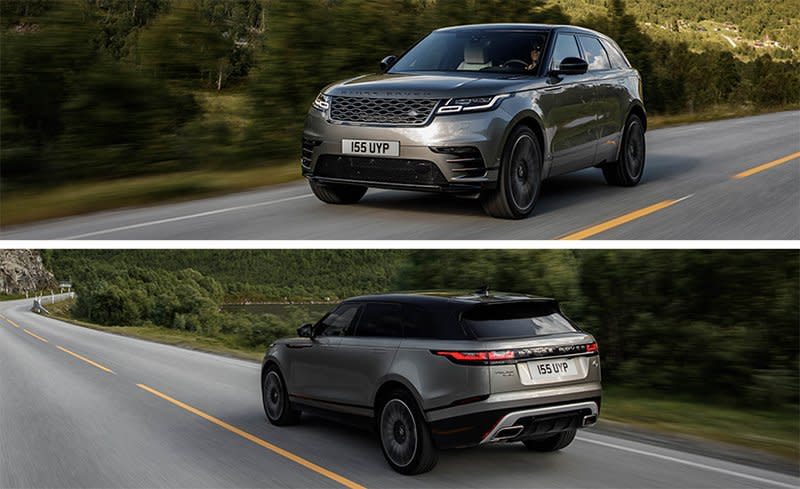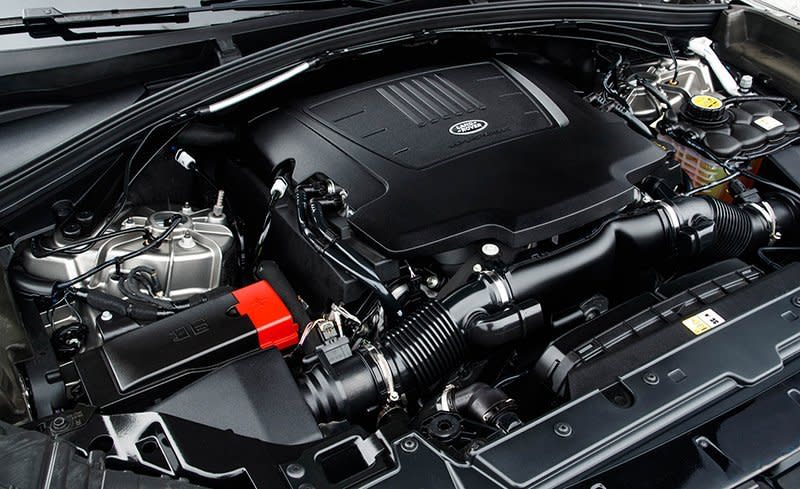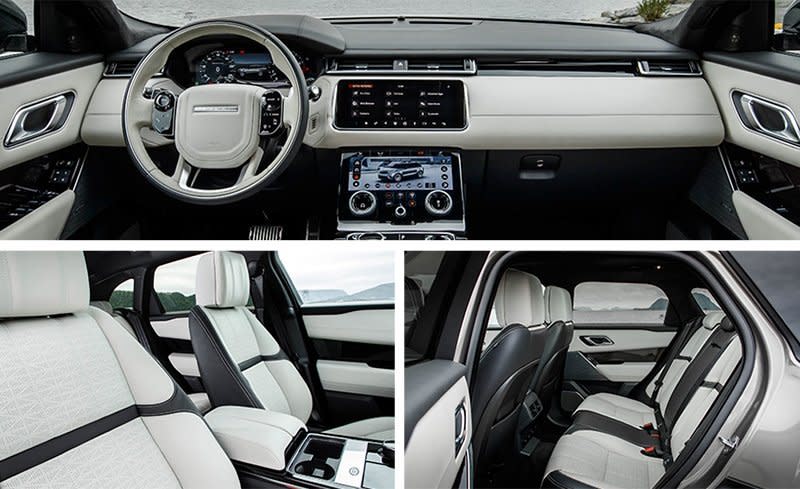2018 Range Rover Velar

In 1969, the Who fully embraced their highfalutin’ arty side with Tommy, a rock opera about a boy disconnected from his senses, who nevertheless has a preternatural aptitude for pinball. Everything from 1970s arena rock to Beyonce’s Lemonade owes at least a tip of the hat to the English foursome’s groundbreaking album. That same year, British Leyland engineers were plying the roads and sheep paths of Blighty in something badged as a Velar—a new type of Land Rover meant for the fox-hunting upper crust.
The Velar badge was a simple ruse constructed from parts-bin L A N D R O V E R letters, and in 1970, while the Who released the raw, Brobdingnagian, Live at Leeds, Land Rover’s erstwhile Velar arrived in European showrooms as the Range Rover. That single, oddball model has since expanded to a full line of SUVs, offering everything from the citified dartabout Evoque to a brand-eponymous long-wheelbase Clydesdale appointed as opulently as anything this side of BMW’s Rolls-Royce operation at Goodwood.

The Punk Meets the Godfather
While the original Range Rover defined a segment that, at the time, nobody in America was quite sure needed defining, with the new Velar the brand now is playing catch-up, patching a hole in its lineup that customers may have filled with a Lexus RX, a BMW X3, or a Mercedes-Benz GLE-class. Previously, those bent on buying British in this class were relegated to the Land Rover LR3/LR4, a trucky, body-on-frame contraption that has taken on the appearance of a shrunken Ford Explorer with its redesign for the 2017 model year, accompanied by a name change to Discovery. Like the Discovery, the Velar can be had with a third row of seats, at a $3050 premium over its $50,895 base price. That starting figure is $90 shy of the Discovery’s, but while the Disco comes with a 340-hp supercharged 3.0-liter V-6 at its $50,985 starting price (2017 model year pricing), the low-end Velar makes do with a 247-horse turbocharged inline-four. If you can’t live without the blown six, expect to spend at least $65,195 to get a 380-hp variant in the Velar S. A 178-hp turbo-diesel four-cylinder with 317 lb-ft of torque also is available, for those who prefer their combustion a bit more unrefined.
Designed as it was to split the difference between the Evoque and the Range Rover Sport, the Velar appropriately resembles an electronic morph between the two vehicles captured at its exact midway point. The new machine features the smaller ute’s chop-top greenhouse set atop a more lithe, elegant version of the Sport’s lower section. Although rich with detail, the graphics don’t feel overwrought or exaggerated, and those who aren’t fond of the trendy copper accents can opt for the R-Dynamic Black package, which offers a dark monochrome offset to the chosen body color.
Going Mobile
On narrow, rural lanes in Norway where we drove it, the Velar’s control-arm front and multilink rear suspension fitted with optional air springs offered an appealing blend of ride comfort and sporty attitude. The only real letdown was the supercharged V-6, which felt a bit coarse, unrefined, and slightly bovine in tone—a far cry from its snotty, spitting character in Jaguar’s F-type sports car. The Velar’s considerable curb weight (we expect it to weigh between 4800 and 5050 pounds) is well controlled under every input other than acceleration, which feels a bit lackluster. Any sense of laggardliness is more of a generalized sensation than a demerit, as Land Rover claims that this hottest Velar makes the run to 60 mph in 5.1 seconds and tops out at 155 mph. While Jaguar Land Rover’s supercharged V-8 remains a model of frivolous, thirsty joy and its new Ingenium four-cylinders are solid performers, the six feels as if it’s aging poorly.

The Velar’s name suggests a direct connection to the full-size Range Rover, although the aesthetics crib from the Evoque’s playbook. We were pleasantly surprised that, in terms of on-road demeanor, the Velar leans more toward the supple, relaxed ride of the big Rangey, rather than the city-ute temperament of its smaller sibling. And in the fully loaded V-6 First Edition example we drove, the interior appointments—save for a cheap-feeling cupholder cover—were up to par and, indeed, felt significantly more luxurious than those of its German and Japanese rivals. Sybarites need look no further.
Rich leather is a given on uplevel Range Rovers, and the top-spec Windsor hide is some of the finest-feeling leather available at the First Edition’s $90,295 price point. More interesting to us is the wool and synthetic suede interior offering, recalling the days when fancy fabrics were just as desirable as the skins of cattle. The dash display is an aesthetic wonderment, featuring a long, sweeping black touchpad beneath a screen looking for all the world like an iPhone 3G subjected to a session on the Spanish Inquisition’s rack. Unlike JLR’s chronically laggy infotainment systems of old, the new TouchPro Duo setup works quickly, if not always in the most intuitive manner. The brand’s Terrain Response driving modes are now selected by tapping an illuminated icon on a flat surface. Not ideal when one would prefer not to remove one’s eyes from the road or trail, but given the Velar’s intended demographic, we imagine that the idea of off-road modes beguiles more than ever selecting them.

Which is a shame, because the Velar is sure-footed and capable on less-than-ideal terrain, scrambling up slick, loose, shale-littered trails with ease and matter-of-factly tackling an indoor obstacle course designed explicitly to show off its capabilities. At one point, a spotter had us hanging in the air, supported by only the right-front and left-rear wheels. He then commanded us to move our head toward the base of the A-pillar. Just a bit of load transfer was enough to gracefully drop the ute down onto its left-front wheel. “That,” the man proclaimed, “shows how well balanced this thing is.” It also illustrates how skilled Land Rover’s guys and gals are at building obstacle courses. While you might not deign to retrace old Camel Trophy routes in the Velar, especially on the First Edition’s flashy 22-inch wheels, it has got more than enough four-wheel moxie to satisfy buyers.
The Kids Are Alright
Back in 1970, only the larger, American Jeep Wagoneer approached the new Range Rover’s blend of off-road capability and luxury, a mélange far removed from Land Rover’s agricultural roots. Today, the eminently civilized Land Rover would like you to know that it has branched out with a full spread of luxe-utility wagons. If you’ve been hesitant to take the plunge before, with the introduction of the Range Rover Velar, the Brits are hoping you’ll accept their invitation to join together with the brand.
Specifications >
VEHICLE TYPE: front-engine, all-wheel-drive, 5- or 7-passenger, 4-door hatchback
BASE PRICES: Si4, $50,895;
S Si4, $55,695;
S Td4, $57,195;
S V6, $65,195;
HSE Si4, $68,595;
HSE Td4, $70,095;
HSE V6, $78,095;
First Edition V6, $90,295
ENGINE TYPES: turbocharged and intercooled DOHC 16-valve 2.0-liter diesel inline-4, 180 hp, 317 lb-ft; turbocharged and intercooled DOHC 16-valve 2.0-liter inline-4, 247 hp, 269 lb-ft; supercharged and intercooled DOHC 24-valve 3.0-liter V-6, 380 hp, 332 lb-ft
TRANSMISSION: 8-speed automatic with manual shifting mode
DIMENSIONS:
Wheelbase: 113.1 in
Length: 189.1 in
Width: 80.0 in Height: 65.6 in
Passenger volume (5-passenger): 99 cu ft
Cargo volume (5-passenger): 34 cu ft
Curb weight (C/D est): 4800–5050 lb
PERFORMANCE (C/D EST):
Zero to 60 mph: 5.5–8.6 sec
Zero to 100 mph: 13.4–27.0 sec
Standing ¼-mile: 130–155 sec
Top speed: 14.1–17.1 mph
FUEL ECONOMY (C/D EST):
EPA combined/city/highway: 18–27/16–24/21–31 mpg

 Yahoo Autos
Yahoo Autos 